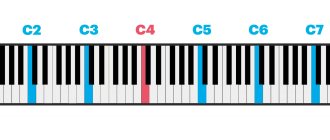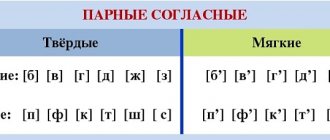Many singers at the beginning of their vocal journey are interested in understanding the key theoretical terms of this profession (among such concepts is timbre). The timbre of the voice determines the tone and color of the sound that is heard during sound reproduction.
It is very difficult to learn vocals without special theoretical knowledge; without it, it can be difficult to evaluate your own vocal or simply speech data and skillfully correct them.
What is timbre and what does it depend on?
Timbre is the sound coloring of the voice, giving it an individual sound. It conveys a person’s emotional state: excitement or joy, fear or anger.
Speech sounds have a fundamental tone and partial subtones called overtones. The combination of overtones creates an individual timbre for each person.
It depends on the physiological characteristics of a person: on the structure of the vocal cords - their length, width, elasticity, mobility, on the volume of the trachea, on the structure of the resonator cavities - the pharynx, oral, nasal cavities, paranasal sinuses.
Types of Voices
All voices are divided into several types depending on the range of sounds that they can cover. For men it is tenor, baritone, bass.
For women - soprano, mezzo-soprano, contralto. Each type is divided into several subtypes, which, being in the same sound range, differ from each other due to the different timbres of the performers.
Tenor is the highest male singing voice.
The following types of tenor are distinguished:
- altino (countertenor). A very high, rare voice, reminiscent of a woman’s;
- light tenor. A high voice that has a lower, chesty overtone;
- lyric tenor It has a soft, delicate color. Its owner was Sergei Lemeshev;
- lyric-dramatic tenor. Close to the lyric tenor, but has deeper overtones;
- dramatic tenor The lowest of the tenors, close to a baritone.
Baritone is a medium-sounding voice and the most common. Baritone is:
- lyrical. Close to the dramatic tenor, but with a deeper tone;
- lyrical-dramatic. The most prominent representative of the baritone family. It was possessed by Muslim Magomaev, Georg Ots;
- dramatic. Lower, stronger, richer shade. Dmitry Hvorostovsky had a dramatic baritone.
Bass is the lowest sounding voice. Bass happens:
- high (bass-baritone). The brightest, lightest representative of the family. The famous owner of the bass-baritone is Fyodor Chaliapin;
- central (dramatic). Solid, sonorous, heavy bass;
- low (bass profundo). Very rare, thick, low voice. Boris Shtokolov had this.
Soprano is the highest female voice. Depending on the timbre, the soprano can be: coloratura, lyric-coloratura, lyric, lyric-dramatic, dramatic. Coloratura soprano is the lightest, sonorous, airiest. Dramatic is the lowest, deepest.
Mezzo-soprano is a medium-high voice. The mezzo-soprano timbre is warm, thick, rich. It can also be coloratura, lyrical, dramatic. Owners of mezzo-soprano are Elena Obraztsova, Lyubov Kazarnovskaya.
Contralto is a low female voice, much less common than soprano and mezzo-soprano. The modern owner of the contralto is the Polish opera singer Ewa Podleszcz.
Children's voices are usually divided into low (alto) and high (soprano for girls, treble for boys).
Vocal abilities in children
Children's voices sound higher than adults'. This is explained by the fact that the vocal muscle in a child under 11-13 years of age is not fully formed. Children's vocals are classified according to their range, regardless of the gender of the child:
- alto - low notes;
- soprano - high notes.
A boy's thin child's voice is called a treble and is divided into low, medium, and high. During the process of mutation of the vocal apparatus, the vocal abilities in children change and may completely disappear.
What can affect the timbre
The following factors can affect the tone:
- Adolescence. In boys, the voice “breaks” - it becomes lower, rougher. This is a natural process established by nature. For girls, such a striking event as “breaking” of the voice does not occur, but as they grow older, it becomes deeper and more expressive.
- Colds. During illness, the voice becomes low and dull, hoarseness appears. After recovery, he returns to his normal state.
- Smoking. Over time, the voice may become lower and rougher, especially noticeable in women.
- Alcohol. Alcohol also has a negative effect on the voice, which becomes hoarse and rough. This happens due to irritation of the vocal cords.
- Stress, emotional overstrain. Because of these factors, a person may have poor control of their voice, which may cause it to tremble, change pitch, become shrill, or rough. When unfavorable factors are eliminated, the voice will return to its normal sound.
- Professions where the voice is an “instrument”. These are singers, announcers, teachers, and tour guides. People in these professions become so accustomed to using their voices at work that even in everyday life they can involuntarily speak somewhat theatrically or excessively loudly. A striking example of this is the scene from the film “The Blonde Around the Corner,” where the main character’s mother, speaking too loudly, explains: “This is professional.” It turns out that she works as a teacher.
- Excessively hot, cold, spicy food negatively affects the ligaments. It makes your voice hoarse and rough, just like alcohol.
- Poor posture. A hunched back does not allow the chest to expand, so the voice becomes quiet and colorless.
- Age-related changes. Hormonal age-related changes in the body lead to loss of elasticity in the ligaments, the voice becomes more rattling and creaky.
How to change the tone
Timbre is given to a person by nature. It depends on the physiological characteristics of the body, so it is fundamentally impossible to change it. But if nasality or hoarseness appears, action must be taken.
For some people, hoarseness adds charm. But if hoarseness causes nothing other than irritation, it is necessary to understand the reasons for its occurrence. It may be the result of an untreated disease, in which case a doctor’s consultation is necessary.
Possible causes may be smoking, drinking alcohol, or eating too spicy or salty foods. Then you should give up bad habits.
Nasality requires a clear consultation with an otolaryngologist, as it is a consequence of untreated ENT diseases that have become chronic. In children, nasal sounds may indicate enlarged adenoids.
It happens that a person simply does not like his voice, although there are no obvious defects (nasality, hoarseness, hoarseness). In this case, special exercises for developing timbre will help.
They won't be able to change your voice beyond recognition, but they will make it cleaner, smoother and deeper. Some exercises help make the tone a little lower.
Exclusive on stage
Sometimes singers are so professional that they are able to perform parts with different characters. Such votes are usually called “absolute”.
For example, the famous singer Maria Callas was able to master all soprano roles - from dramatic to coloratura. Her appearance on stage in exquisite outfits and furs caused a sensation. But such opportunities open up only to unique voices with careful development of sound techniques.
It is almost impossible to determine the type of voice of a beginning singer, since the degree of range and timbre change during training.
How to hear your real voice
Others hear a person’s speech differently than he does. There is an interesting way to hear yourself the way others hear.
To do this, you need to take sound reflectors - two pieces of cardboard or thin folders - and place them edge-on to your head in front of your ears. You can even just place your palms edgewise, depicting a kind of Cheburashka.
Now you need to say something out loud - the sound reflector will not allow the voice to penetrate directly into the ears and the person will hear the sound reflected from the surrounding surfaces, as others hear it.
This little experience will help you hear yourself from the outside, evaluate possible shortcomings, and start working with your voice.
Exercises for developing timbre
For a beautiful, natural sounding voice, it is necessary to carry out special exercises. They will allow you to relax the muscles of the face, larynx, diaphragm, and vocal cords.
First you need to start watching your posture - straighten your back, straighten your shoulders, tighten your stomach. As noted above, this will help expand the chest and make the voice stronger.
"Model"
A very simple exercise helps to relax the facial muscles - you need to open your mouth slightly, like a fashion model on set. For all its simplicity, it perfectly helps to relax the muscles around the mouth.
"Horse"
Another exercise to relax your facial muscles is to stretch your lips forward and snort like a horse.
"Yawn"
This is an exercise to relax the larynx. You need to throw your head back and open your mouth wide, imitating a yawn. At the same time, you can say “aaaaa” in a drawn-out manner, changing the tonality. It is likely that after completing the exercise you will really want to yawn. This is very good, because a natural yawn perfectly relaxes the larynx.
To relax the diaphragm, it is very important to learn to breathe with your stomach. Most adults breathe through the chest; in this case, the diaphragm is compressed. The result is a weak and inexpressive voice.
"Sound M"
To relax the muscles of the larynx and face, you need to exhale and say “mmmmm” with your mouth closed.
"Sound I"
To make your voice sound a little lower, it is recommended to do the following exercise: sit down, lower your head down so that your chin touches your chest. Pronounce the sound “iiiiii” in a low voice and slowly raise your head, trying to maintain the pitch of the sound being pronounced. At first it will be difficult - the tonality will increase, but as you practice, the pitch in both positions will become the same.
To lower the timbre, you need to control the speed of speech. The higher the speed, the higher the voice.
You need to do the exercises every day, devoting 10 to 15 minutes to them. After 3-4 weeks of regular practice, you will be able to hear the result - your voice will become deeper and more expressive.
Related posts:
- What is "War and Peace" about? Summary of the novel “War and Peace” by chapters. All answers...
- How to get your lost voice back? It happens that the voice disappears at the most inopportune moment. Symptoms, exercises...
- Logorhythmic classes and correctional means By various means, speech therapy classes contribute to the effective correction of speech in children...
- From experience in diagnosing and forming creative imagination Research on creative imagination - diagnosis and its formation in children...
Basic steps for voice training
In fact, to positively influence the characteristics and properties of your voice, you need to master just a few important things. They have a universal effect on the basic characteristics of the voice and, if you master them completely, you will improve absolutely everything.
What affects voice characteristics:
- Breathing and support.
- Diction and articulation.
- Working with resonators.
In addition, you must definitely work on getting rid of tension - any unpleasant sensations in the chest, jaw, throat, neck, cheekbones and other parts of the body. If discomfort occurs when you begin to speak, this is a sure sign of tension. We will talk in more detail about the fight against clamps in the “Diction and Articulation” section, where we will give the simplest exercises for removing clamps.
Let us note that all the exercises offered in this course are a symbiosis of recommendations from professionals who work with the voice in one way or another: doctors, lecturers, announcers, artists, vocalists, etc. We have simplified all the tips to a level where anyone can use them, including those who do not have speaking abilities and have never been involved in voice development.
Breathing and support
In any public speaking course, in any vocal school, training begins with breathing. Sometimes you can come across the phrase “correct breathing,” but we will not use it. In fact, there is no right or wrong breathing - there are certain tasks that are facing you at the moment.
The breathing that is necessary simply to supply the body with oxygen differs from the breathing that is necessary for the purpose of correctly producing beautiful sounds. Just in order for your voice to be beautiful, you need to master the correct sound production . And this can only be achieved when you have trained breathing and support for sound.
What does trained breathing and voice support provide:
| 1 | the basis of beautiful sound; |
| 2 | access to high notes (for singers; |
| 3 | lightness and flight of voice; |
| 4 | prevention of clamps of ligaments and other parts of the body; |
| 5 | endurance of the vocal apparatus. |
How to achieve all this? Let's look at a step-by-step algorithm for establishing breathing and finding support for your voice so that it sounds beautiful and bright.
Steps to establish breathing and support your voice:
- Take a deep, quick breath through the nose into the lower part of the lungs - so that the stomach and sides in the lower part swell. Important: shoulders should not rise!
- Hold your breath in such a way that the stomach and sides remain in a fixed bloated state, i.e. air retention using the abdominal muscles.
- Gradual exhalation with minimal air consumption, without sudden loss of air.
These are the fundamental differences between breathing, which is simply necessary for the functioning of the body, and breathing, which is necessary for confident sound production. If we normally breathe into the upper part of our lungs, then to give a lecture or any other public speaking we need to fill most of the lungs with air.
There is one more nuance: it is advisable to inhale so much air that it is enough for the spoken phrase, no more and no less. If you inhale less, the end of the phrase will sound slurred and strained, because. you don't have enough air to sound normal. If you inhale more and, at the end of the phrase, begin to draw in air again, the spoken phrases will also begin to sound slurred, and it will be difficult for you to control the flow of air so that it comes out gradually, without sudden jerks. The skill of controlling the volume of air inhaled comes with training and practice.
Breathing and support exercises:
- Relax your upper body - stand up straight, lower your shoulders, take a deep breath and exhale, slowly turn your head left and right, shake or sway your lowered arms, then slightly round your back and lean a little forward, shake or sway your lowered arms a little more, return to the starting position.
- Take a deep, quick breath through the nose into the lower part of the lungs - so that the stomach and sides in the lower part swell. You can help yourself by leaning forward a little, rounding your back. This will give air a clearer path into your lungs. Hold your breath as long as you can. If you can hold it for at least 30 seconds, this is a good result. Repeat 3 times.
- Take a deep, quick breath through the nose into the lower part of the lungs - so that the stomach and sides in the lower part swell. You can help yourself by leaning forward a little, rounding your back. Hold your breath for a moment and begin to slowly exhale the air with a “sssssssss” sound, while continuing to keep your sides and stomach distended. If you can hold out for at least 30 seconds, this is a good result. Repeat 3 times.
While doing the exercises, look in the mirror and control the position of the abdomen and sides (they should be swollen) and the position of the shoulders (they should be lowered and should not rise).
If you perform the exercises correctly, you should not have any discomfort in your neck, shoulders, jaw, or vocal cords. Only slight abdominal fatigue is possible if you are not a very trained person and are not particularly fond of sports.
If, when performing exercises 2 and 3, you feel discomfort in the neck, shoulders, jaw, vocal cords, immediately stop performing them and return to exercise 1 to relax the upper body.
We draw your attention to an important nuance: the exercises offered in the course do not help everyone, but only those who do them! We strongly recommend that you master the above exercises so that in subsequent lessons you can move on to tasks of a higher level of complexity, which are also necessary for the development of a beautiful voice and speech.
Let's continue the topic. You can learn a lot about relaxation, liberation, inhalation and exhalation for a better sounding voice from the experience of current and already successful artists. As an example, we can suggest watching the lessons given by Russian singer Polina Gagarina as part of the “Generation M” charity project. Lesson No. 1 touches on the topic of relaxation, emancipation and freedom of voice:
And in lesson No. 2, Polina Gagarina explains in detail and demonstrates the above-described breathing technique:
To achieve the desired effect - breathing training and finding support for the voice - you need to perform these exercises daily for 2 weeks. Then you can return to these exercises 1-2 times a week so as not to lose the acquired form. You can read more about breathing and finding support for the voice in the work of the Italian surgeon, otolaryngologist and phoniatrist Franco Fussi, La respirazione e l'appoggio nel canto (“Breathing and support in singing”) [F. Fussi, 2017].
Let us clarify that the principles of sound production for singing and spoken speech are similar. The only difference is in the depth of the required elaboration: if in everyday life we can decide for ourselves whether we need to sound beautiful and convincing, then for singers this is part of their profession by default. Therefore, if you master the breathing technique practiced by opera and pop performers , speaking in front of a large audience will be easy for you.
Diction and articulation
The next important step in voice production is diction and articulation. It’s not for nothing that these concepts stand side by side. They are so closely interconnected that one without the other is simply impossible. Without clear articulation, good diction is impossible. At the same time, overly active articulation can make sounds rougher.
Articulation is the totality of the work of the speech organs in the formation of speech sounds. Clear articulation of sounds depends on the degree of training of the active organs of speech, primarily the tongue and lips.
Diction is the clear pronunciation of vowels and consonants in accordance with the phonetic norms of the language you are speaking or singing at the moment. Diction directly determines how clear and energetic our speech is.
Working on diction and articulation, in addition to the self-evident results in the form of clear, understandable sounds, has another significant bonus. This is the removal of clamps from the throat , which are common in our era of everyone sitting in front of computers and gadgets.
What good diction and articulation gives:
| 1 | clarity and clarity of pronunciation of sounds; |
| 2 | expressiveness and energy in the voice; |
| 3 | access to long notes (for singers; |
| 4 | more lively facial expressions; |
| 5 | getting rid of tension in the throat area. |
Separate mention should be made about the clamps. Without removing the clamps, good articulation is impossible , but at the same time, working on articulation allows you to gradually begin to get rid of the clamps. Note that the articulatory apparatus is quite complex and, in addition to the tongue and lips, a large number of muscles are involved in articulation.
The structure of the articulatory apparatus:
Diagram of the location of the muscles involved in articulation:
A clamp in any of these muscles can negate all your efforts to develop clear expressive speech, so if you cannot localize the problem on your own, consult a speech therapist or perform universal exercises to remove clamps, improve diction and articulation.
Exercises for removing clamps:
- Relax your face, neck, and all articulatory muscles. To do this, shake your head slightly left and right, back and forth. Important: avoid sudden movements and do not try to achieve maximum range of motion. If you feel discomfort or hear any clicking or other sounds, skip this exercise. If discomfort in the neck and articulatory muscles is your permanent condition, find the opportunity to consult a neurologist or surgeon.
- Practice keeping your neck and head straight. Test how well you can do this by placing a book on your head. If a closed book does not hold well, practice with an open book for now, placing it with its open pages on top of your head. Once you have managed to hold the book on your head at rest, try holding it while you speak. Any text that does not require you to bend over to read it from a sheet of paper or computer will do.
You can see more exercises on relaxation and removing tension in the lessons of Polina Gagarina. They are equally suitable for artists, singers, lecturers and all people who have to talk a lot:
Exercises to improve diction and articulation (perform in front of a mirror):
- Tongue mobility training – stretch it forward as much as possible, try to “reach” the tip of your nose and chin with your tongue.
- Mouth position training - open your mouth so that 2 fingers, folded one above the other, fit into it. The tongue should remain flat and rest against the lower teeth. Make the sounds “a-a” so that your mouth does not close, your tongue does not arch or “go” back. It is also useful to practice the sounds "nga-ngo-ngy-nge-ngu-nga" and make sure that the mouth remains wide open.
- Training the interaction of the jaw and tongue - open your mouth, lowering and moving your jaw slightly back. To control the position, place your finger on your lips as if you want to say “shhh, hush.” The lower lip should not touch the finger when the mouth is open. Say the vowel "a". The tongue should remain flat and rest against the lower teeth. Make sure that the tongue does not bend or “go” back.
- Training in sound formation in the upper palate - turn on the recorder, make a grin and grin and try to pronounce some words (a poem, a presentation text, an answer to an exam paper) in this position. If you did everything correctly, the sound will be clearer, brighter and more spacious than usual.
- Training in the formation of sound in the upper palate plus training in the pronunciation of consonants - turn on the recorder, make a grin, relax your jaw and hold a pencil in your teeth. Try saying some text in this position. Take out the pencil and repeat the same text, just holding the grin. If you did everything correctly, when comparing audio recordings you will hear that the last version of the text sounded better than the first.
By the way, as British doctor Leonard Jane assures, squeezing a pencil between your teeth can help relax your jaw muscles and reduce the intensity of headaches [Dailymail, 2016]. So if you have headaches, voice training will have the added bonus of making you feel better.
And, of course, tongue twisters help develop diction and articulation. Don’t try to pronounce them quickly right away, don’t immediately tackle long and complex ones. It’s better to start by taking 2-3 simple tongue twisters in Russian and English and practice them at a slow pace, then at an average pace, and only then at a fast pace.
We will return to the topic of diction development and more detailed recommendations for its development in a separate lesson. Now let’s explore another powerful way to influence the characteristics of your voice and control its sound at your discretion.









